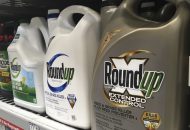EPA to Designate ‘Forever Chemicals’ as Hazardous Substances

WASHINGTON (AP) — The Environmental Protection Agency is designating some toxic industrial compounds used in cookware, carpets and firefighting foams as hazardous substances under the so-called Superfund law.
The designation means that releases of long-lasting chemicals known as PFOA and PFOS that meet or exceed a certain quantity would have to be reported to federal, state or tribal officials. The requirement would increase understanding of the extent and locations of the contamination and help communities avoid or reduce contact with the potentially dangerous chemicals, the EPA said.
PFOA and PFOS have been voluntarily phased out by U.S. manufacturers but are still in limited use and remain in the environment because they do not degrade over time. The compounds are part of a larger cluster of “forever chemicals” known as PFAS that have been used in consumer products and industry since the 1940s.
PFAS is short for per- and polyfluoroalkyl substances, which are used in nonstick frying pans, water-repellent sports gear, stain-resistant rugs, cosmetics and countless other consumer products.
The chemicals can accumulate and persist in the human body for long periods of time, and evidence from animal and human studies indicates that exposure to PFOA or PFOS may lead to cancer or other health problems.
“Communities have suffered far too long from exposure to these forever chemicals,” EPA Administrator Michael Regan said in a statement Friday. “The action announced today will improve transparency and advance EPA’s aggressive efforts to confront this pollution.”
Under the proposed rule, “EPA will both help protect communities from PFAS pollution and seek to hold polluters accountable for their actions,” Regan said.
The EPA’s action follows a recent report by the National Academies of Science that calls PFAS a serious public health threat in the U.S. and worldwide.
Regan said many sources of PFAS contamination are near communities already overburdened with pollution. The proposed rule would provide the agency with improved data and the option to require cleanups and recover cleanup costs to protect public health, he said.
The move follows an EPA announcement in June that PFOA and PFOS are more dangerous than previously thought and pose health risks even at levels so low they cannot currently be detected.
The agency issued nonbinding health advisories that set health risk thresholds for PFOA and PFOS to near zero, replacing 2016 guidelines that had set them at 70 parts per trillion. The chemicals are found in products including cardboard packaging, carpets and firefighting foam and increasingly found in drinking water.
The EPA said in a statement that it is focused on holding responsible those who have manufactured and released significant amounts of PFOA and PFOS into the environment. The agency also said it is committed to further outreach and engagement to hear from communities affected by PFAS pollution.
Several states have set their own drinking water limits to address PFAS contamination that are far tougher than the federal guidance.
The revised health guidelines issued in June are based on new science and take into consideration lifetime exposure to the chemicals. Officials are no longer confident that PFAS levels allowed under the 2016 guidelines are safe from adverse health impacts, an EPA spokesman said.
Attorney Rob Bilott, an anti-PFAS advocate, said the EPA’s proposal “sends a loud and clear message to the entire world that the United States is finally acknowledging and accepting the now overwhelming evidence that these man-made poisons present substantial danger to the public health and the environment.”
Bilott, whose work to uncover the widespread presence of PFAS chemicals in the environment and in human blood was highlighted in the 2019 film “Dark Waters,” represents states, water providers and others affected by PFAS contamination. He said in a statement that any hazardous substance designation under the Superfund law must be implemented so the costs of cleaning up the toxins are borne by PFAS manufacturers who caused the contamination — “not the innocent victims of this pollution who didn’t create the toxins and were never warned any of this was ever happening.”
The EPA said it expects to propose national drinking water regulations for PFOA and PFOS later this year, with a final rule expected in 2023.


























